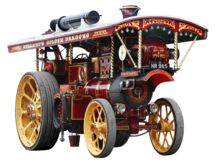
Back Historia de los vehículos de carretera a vapor Spanish Höyrykäyttöisten maantieajoneuvojen historia Finnish Histoire des véhicules routiers à vapeur French A közúti gőzjárművek története Hungarian Storia dei veicoli stradali a vapore Italian Tvaika autotransporta līdzekļu vēsture Latvian/Lettish Istoria vehiculelor rutiere cu aburi Romanian Zgodovina parnih cestnih vozil Slovenian Історія парових дорожніх транспортних засобів Ukrainian

The history of steam road vehicles comprises the development of vehicles powered by a steam engine for use on land and independent of rails, whether for conventional road use, such as the steam car and steam waggon, or for agricultural or heavy haulage work, such as the traction engine.
The first experimental vehicles were built in the 18th and 19th century, but it was not until after Richard Trevithick had developed the use of high-pressure steam, around 1800, that mobile steam engines became a practical proposition. The first half of the 19th century saw great progress in steam vehicle design, and by the 1850s it was viable to produce them on a commercial basis. This progress was dampened by legislation which limited or prohibited the use of steam-powered vehicles on roads. Nevertheless, the 1880s to the 1920s saw continuing improvements in vehicle technology and manufacturing techniques, and steam road vehicles were developed for many applications. In the 20th century, the rapid development of internal combustion engine technology led to the demise of the steam engine as a source of propulsion of vehicles on a commercial basis, with relatively few remaining in use beyond the Second World War.
Many of these vehicles were acquired by enthusiasts for preservation, and numerous examples are still in existence. In the 1960s, the air pollution problems in California gave rise to a brief period of interest in developing and studying steam-powered vehicles as a possible means of reducing the pollution. Apart from interest by steam enthusiasts, occasional replica vehicles, and experimental technology, no steam vehicles are in production at present.
Early steam-powered vehicles, which were uncommon but not rare, have considerable disadvantages as seen from a 21st-century viewpoint. They were slow to start, as water had to be boiled to generate the steam. They used a dirty fuel (coal) and put out dirty smoke. Fuel was bulky and had to be shoveled onto the vehicle and then into the firebox. Like a furnace, hot ash had to be removed and disposed of. The engine needed to be replenished with water in addition to fuel. Most vehicles had metal wheels and less than excellent traction. They were heavy. In most cases the user had to do their own maintenance. Top speed was low, about 20 miles (32 km) per hour, and acceleration was poor.
Steam vehicle technology evolved over time. Later steam vehicles used cleaner liquid fuel (kerosene), were fitted with rubber tyres and condensers to recover water, and were lighter overall. These improvements were not enough to keep pace with internal-combustion engines, however, which ultimately out-competed steam and remained dominant for the rest of the 20th century.
© MMXXIII Rich X Search. We shall prevail. All rights reserved. Rich X Search